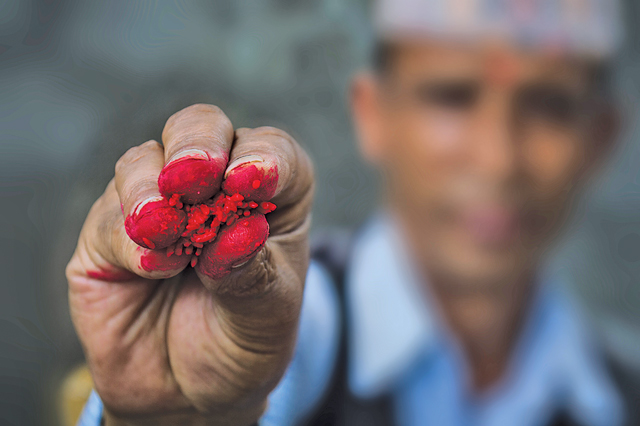Call it a beauty mark, the spiritual third eye, a sign of devotion to gods or a symbol of matrimony, the tika is a much celebrated and integral part of Hindu religious practice.

Go to a temple and what is the one thing you will see common among the people? Apart from voices swaying ceremoniously in meditational chant and the devotion and love towards the higher self in people’s eyes, the one thing that is characteristically shared by Hindu devotees, is the dot on their foreheads, the anointment of the crimson tika.
Call it a beauty mark, the spiritual third eye, a sign of devotion to gods or a symbol of matrimony, the tika is a much celebrated and integral part of Hindu religious practice. Made of dried turmeric, the tika symbolizes purity of submission and devotion. Interestingly, the tradition of putting the tika is not mentioned in the vedas and puranas even once. Yet, it has always served its purpose as an embedded ritual in the daily lives of Hindu devotees.
Not being prescribed in religious texts gives the tika its variable form, a new kind of tika depending on region, culture and occasion. The small red tika worn everyday especially by women, a big red one covering a handsome portion of the forehead (mostly seen during dashain), a white tika (the shiva tilaka), an orange tika worn by devotees of the monkey god and a yellow tika. On the festival of bhai tika, a day celebrated by brothers and sisters, though, we see a tika of different colors etched linearly on their foreheads.
The tika is at once, a symbol of worship and religious omen giving it important significance in the daily practice of the Hindu culture. The tika is considered the point at which creation began. It has also been described as “the sacred symbol of the cosmos in its unmanifested state”. Traditionally, the area between the eyebrows is said to be the sixth chakra, the ajna, the seat of “concealed wisdom”. Applied in the center of the forehead close to the eyebrow, the tika anoints the Ajna Chakra and thus is considered to be associated with the third eye chakra. The tika is said to focus energy and increase concentration. It is also known to be the circle or dot around which the mandala is created; a spiritual symbol, a symbol of nirvana. The dot is meant to denote the center point for one’s spiritual destiny and serve as a medium for personal sanctification.
There are twelve spots in the body where the tika can be applied after bathing, though it is not a common practice to do so. These places include the forehead, the throat, the heart, the stomach, two shoulders, arms, and so on. Each time a mark is applied, the name of a particular deity is recited. This touching, marking, and evocation brings the effect of consecration to the body and the individual. The practice of putting the tika usually follows after offering prayers or religious ceremonies. For devotees who pray at home every day, the tika is a customary part of their appearance. Religious practice permits the tika to be put only after one has taken a bath and cleansed the body. Sanctification of the soul, after all demands bodily hygiene as well.
The symbolic little dot carried by devotees on their forehead comes to contain within itself a vast sea of spiritual devotion. What to the foreign eye may be perceived as mere ornamentation, is a ritual of faith for the devotee. It is a practice to obtain spiritual sanctity, a means to connect with the gods, the method to awaken the third eye and the goodness within. It is a crimson dot of faith that all of this can, after all, be realized and achieved.











